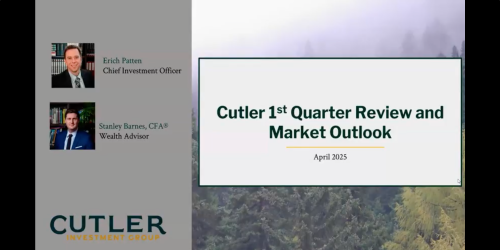Cutler Commentary
Q1-2025 Market Commentary:
April 03, 2025

What to do in a falling market?
“Fear is a reaction. Courage is a decision.” — Winston Churchill
“Do not anticipate trouble, or worry about what may never happen. Keep in the sunlight.” — Benjamin Franklin
“I’ve had a lot of worries in my life, most of which never happened.” — Mark Twain
On November 30th, 2022, ChatGPT launched to the public. Within five days this technology had over 5 million users and grew to 100 million in just two months! The Artificial Intelligence race was launched, promulgating capital investment previously unheard of. Microsoft invested nearly $14 billion into OpenAI (the owner of ChatGPT) six months after the launch. In 2024, investment was skyrocketing as the Magnificent 7 (Apple, Amazon, Alphabet, Microsoft, META, NVIDIA, and Tesla) spent an estimated $200 billion (or more) on data centers! And the stock market took notice. Stocks, largely on the heels of NVIDIA (which sells chips for these data centers) rallied for two consecutive years. The S&P 500 was up 24.2% and 23.3% in 2023 and 2024, respectively. As we entered 2025, the Magnificent 7 companies planned to spend $330 billion on this new technological advancement. That’s a total of $500 billion in just the past 24 months, and they haven’t announced any plans to slow down.
We hope that you notice what is distinctly missing from that previous paragraph. Politics. In the noisy re-launch of the Trump administration, political headlines have dominated the news cycle. In this divisive period of global politics, it is important for each of us to have strong beliefs and to be engaged. But, as your financial advisors, it is our objective to keep political bias removed from your portfolio. Regardless of your ideology, we continue to believe that the stock market is the best way to invest and build long-term value!
We must recognize, however, that politics have influenced investor sentiment in the First Quarter and into April. Anticipation of higher tariffs led to huge imports of gold and a front-loading of imported inventory in January. The result is a first quarter Gross Domestic Product (GDP) growth figure that has dropped from 2.8% in the previous year to what we estimate will be near 0% in the first quarter of 2025. And on April 2nd, President Trump announced the highest tariffs in a century on all US trading partners. Stocks, already having sold-off due to tariff uncertainty, lost nearly 5% in a single session- the biggest drop for the S&P 500 since 2020’s pandemic. Certain sectors and industries have been more impacted by announced tariffs and geo-political tensions, such as automotive stocks and airlines. Airline stocks just had their worst quarter in five years. Other highflyers from the past two years, such as “risk-on” Magnificent 7 stocks NVIDIA and Telsa, were down over 20% and 30% respectively for the quarter (both still have significant gains in the past 12 months). Including the April 3rd sell-off, the Magnificent 7 stocks were down on average 24% year-to-date. “Risk off” has been the theme this year as investors took a cautious approach to increasingly escalating trade tensions.
After two consecutive years of 20%+ returns, a consolidation of the stock market is not unwarranted. In Cutler’s view, the stock market was due for a rotation. After all, trees don’t grow to the sky and the valuations of the Magnificent 7 could not continue to increase indefinitely. Dividend stocks, long a bedrock of Cutler’s investment philosophy, looked particularly attractive based on valuations. International equities, having underperformed for over a decade, traded at historically low levels compared to US equities. These trends reversed in the First Quarter in a significant way. The Russell 1000 Value (value stocks, often corresponding to dividend stocks) finished up 1.8%, the MSCI EAFE (international developed stocks) up 7.8%, and the Bloomberg Aggregate (bonds) was up 2%. Meanwhile, the S&P 500 was down 4.3% in the quarter (8.2% after April 3rd), while the Russell 1000 Growth (associated with technology and the Magnificent 7) was down 9.8% in the first quarter. In summary, diversification is working! After numerous years where Growth stocks were seemingly the only game in town, investors are rotating into dividends, bonds, global equities, and gold*. We continue to advocate for an asset allocation with broad exposures, including exposure to Growth stocks that are currently not in favor.
So, what does Cutler anticipate from here? After a January rally, the quarter-end levels of the S&P 500 are around 10% lower than the market peak on February 19th. 10-20% drops are commonly referred to as Market Corrections, while a 20% threshold is considered a Bear Market. Is today’s Market Correction just a pitstop on the way to a Bear Market? If the answer to this question turns out to be ‘yes,’ it would imply deteriorating economic fundamentals. While certainly possible, we haven’t yet seen scaling back of capital investment or systemic job cuts outside of the Federal workforce. As we described in the opening paragraph, capital investment in the private sector remains strong. Our biggest concern is a drop in consumer sentiment from trade tensions and the cost of goods from tariffs. University of Michigan Consumer Sentiment surveys have turned notably lower and inflation expectations are marching higher. With consumer spending representing two-thirds of the US economy, we are monitoring if consumers meaningfully pull back spending. While we wouldn’t rule out that things could get worse, our baseline case is not a recession nor a subsequent Bear Market.
Even so, long-term investors understand that Bear Markets are a painful part of a successful investment approach. There have been 15 Bear Markets since 1945, with an average frequency of every 5.1 years. The average investor should anticipate persevering through 14 Bear Markets. Given all of today’s uncertainty, why should we invest through a Bear Market? For more on this, tune in to Cutler’s First Quarter Market webinar, but the short answer is that optimism has prevailed in the stock market for a century. The S&P 500 has historically gone up 73% of the time over 1-year periods, 84% over 3-year periods, and 88% of the time over 5-year periods!
*Gold is not currently included in Cutler’s recommended portfolio allocation models.
Past performance is not indicative of future results. Strategies referenced herein may be materially different than actual positions held in client accounts. Different types of investments involve varying degrees of risk, and there can be no assurance that any specific investment or strategy will be profitable or suitable for a particular investor's financial situation or risk tolerance. Investing involves risk, including loss of principal. You cannot invest directly in an index. Nothing herein should be considered a recommendation to buy or sell a security, including any securities, mutual funds, or ETFs specifically provided as examples. Asset allocation and portfolio diversification cannot assure or guarantee better performance and cannot eliminate the risk of investment losses. Neither Cutler Investment Counsel, LLC nor its information providers are responsible for any damages or losses arising from any use of this information.
The S&P 500 Index is widely regarded as the best single gauge of large-cap U.S. equities. The index includes 500 leading companies and captures approximately 80% coverage of available market capitalization.
The Barclay’s Aggregate Bond Index (Taxable Bond) is a broad base, market capitalization weighted bond market index
representing intermediate term investment grade bonds traded in the United States.
Headline Inflation is the raw inflation figure reported through the Consumer Price Index (CPI) that is released monthly by the Bureau of Labor Statistics.
The Bloomberg Commodity Index (Commodities) is an index of the prices of items such as wheat, corn, soybeans, coffee, sugar, cocoa, hogs, cotton, cattle, oil, natural gas, aluminum, copper, lead, nickel, zinc, gold and silver. The index is calculated on an excess return basis and reflects commodity futures price movements.
The MSCI EAFE Index (Foreign Developed Index) is designed to represent the performance of large and mid-cap securities across 21 developed markets, including countries in Europe, Australasia and the Far East, excluding the U.S. and Canada.
The MSCI Emerging Markets Index captures large and mid-cap representation across 27 Emerging Markets (EM) countries. With 1,392 constituents, the index covers approximately 85% of the free float-adjusted market capitalization in each country.
Bitcoin Each crypto index is made up of a selection of cryptocurrencies, grouped together and weighted by market capitalization (market cap). The market cap of a cryptocurrency is calculated by multiplying the number of units of a specific coin by its current market value against the US dollar.
Source: Morningstar All opinions and data included in this commentary are as of March 31, 2025 and are subject to change. The opinions and views expressed herein are of Cutler Investment Counsel, LLC and are not intended to be a forecast of future events, a guarantee of future results or investment advice. This report is provided for informational purposes only and should not be considered a recommendation or solicitation to purchase securities. This information should not be used as the sole basis to make any investment decision. The statistics have been obtained from sources believed to be reliable, but the accuracy and completeness of this information cannot be guaranteed.
CATEGORIES
Disclaimer
These blogs are provided for informational purposes only and represent Cutler Investment Group’s (“Cutler”) views as of the date of posting. Such views are subject to change at any point without notice. The information in the blogs should not be considered investment advice or a recommendation to buy or sell any types of securities. Some of the information provided has been obtained from third party sources believed to be reliable but such information is not guaranteed. Cutler has not taken into account the investment objectives, financial situation or particular needs of any individual investor. There is a risk of loss from an investment in securities, including the risk of loss of principal. Different types of investments involve varying degrees of risk, and there can be no assurance that any specific investment will be profitable or suitable for a particular investor's financial situation or risk tolerance. Any forward looking statements or forecasts are based on assumptions and actual results are expected to vary. No reliance should be placed on, and no guarantee should be assumed from, any such statements or forecasts when making any investment decision.




